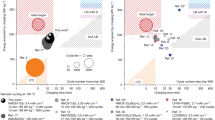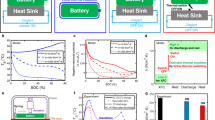Abstract
Lithium-ion batteries suffer severe power loss at temperatures below zero degrees Celsius, limiting their use in applications such as electric cars in cold climates and high-altitude drones1,2. The practical consequences of such power loss are the need for larger, more expensive battery packs to perform engine cold cranking, slow charging in cold weather, restricted regenerative braking, and reduction of vehicle cruise range by as much as 40 per cent3. Previous attempts to improve the low-temperature performance of lithium-ion batteries4 have focused on developing additives to improve the low-temperature behaviour of electrolytes5,6, and on externally heating and insulating the cells7,8,9. Here we report a lithium-ion battery structure, the ‘all-climate battery’ cell, that heats itself up from below zero degrees Celsius without requiring external heating devices or electrolyte additives. The self-heating mechanism creates an electrochemical interface that is favourable for high discharge/charge power. We show that the internal warm-up of such a cell to zero degrees Celsius occurs within 20 seconds at minus 20 degrees Celsius and within 30 seconds at minus 30 degrees Celsius, consuming only 3.8 per cent and 5.5 per cent of cell capacity, respectively. The self-heated all-climate battery cell yields a discharge/regeneration power of 1,061/1,425 watts per kilogram at a 50 per cent state of charge and at minus 30 degrees Celsius, delivering 6.4–12.3 times the power of state-of-the-art lithium-ion cells. We expect the all-climate battery to enable engine stop–start technology capable of saving 5–10 per cent of the fuel for 80 million new vehicles manufactured every year10. Given that only a small fraction of the battery energy is used for self-heating, we envisage that the all-climate battery cell may also prove useful for plug-in electric vehicles, robotics and space exploration applications.
This is a preview of subscription content, access via your institution
Access options
Subscribe to this journal
Receive 51 print issues and online access
$199.00 per year
only $3.90 per issue
Buy this article
- Purchase on Springer Link
- Instant access to full article PDF
Prices may be subject to local taxes which are calculated during checkout




Similar content being viewed by others
References
Armand, M. & Tarascon, J. M. Building better batteries. Nature 451, 652–657 (2008)
Villasenor, J. High-altitude surveillance drones: coming to a sky near you. Sci. Am. Feb, 24 (2012)
Extreme temperatures affect electric vehicle driving range, AAA says. http://newsroom.aaa.com/2014/03/extreme-temperatures-affect-electric-vehicle-driving-range-aaa-says/Newsroom (20 March 2014)
Ji, Y., Zhang, Y. & Wang, C. Y. Li-ion cell operation at low temperatures. J. Electrochem. Soc. 160, A636–A649 (2013)
Zhang, S. S., Xu, K. & Jow, T. R. A new approach toward improved low temperature performance of Li-ion battery. Electrochem. Commun. 4, 928–932 (2002)
Smart, M. C., Whitacre, J. F., Ratnakumar, B. V. & Amine, K. Electrochemical performance and kinetics of Li1+x(Co1/3Ni1/3Mn1/3)1−xO2 cathodes and graphite anodes in low-temperature electrolytes. J. Power Sources 168, 501–508 (2007)
Vlahinos, A. & Pesaran, A. A. Energy efficient battery heating in cold climates. Society of Automotive Engineers (SAE) Technical Paper 2002–01–1975, http://papers.sae.org/2002-01-1975/ (SAE, 2002)
Stuart, T. A. & Handeb, A. HEV battery heating using AC currents. J. Power Sources 129, 368–378 (2004)
Ji, Y. & Wang, C. Y. Heating strategies for Li-ion batteries operated from subzero temperatures. Electrochim. Acta 107, 664–674 (2013)
Chen, K. et al. Evaluation of the low temperature performance of lithium manganese oxide/lithium titanate lithium-ion batteries for start/stop applications. J. Power Sources 278, 411–419 (2015)
Gröger, O., Gasteiger, H. A. & Suchsland, J.-P. Electromobility: batteries or fuel cells? J. Electrochem. Soc. 162, A2605–A2622 (2015)
Acknowledgements
We thank W. Zhao and C. E. Shaffer for early discussions on using battery simulation software to discover the all-climate battery. This work was inspired by US patent publication numbers 2014-0342194, 2015-0303444 and 2015-0104681 and Patent Cooperation Treaty publication numbers WO 2014/186195, WO 2015/102709 and WO 2015/102708.
Author information
Authors and Affiliations
Contributions
C.Y.W. developed the concept and wrote the manuscript. S.G., T.X., Y. J. and X.G.Y. designed and built the cells, G.Z. built the test stand and carried out the performance characterization, and Y.L. performed the cycle life experiments. All authors contributed to development of the manuscript and to discussions as the project developed.
Corresponding author
Ethics declarations
Competing interests
C.-Y.W. is the founder and chief technology officer of and has an equity stake in EC Power, an academic spin-off company working in the field of battery and fuel cell technologies. The remaining authors declare no competing financial interests. The all-climate battery is the subject of patent protection including US patent publication numbers 2014-0342194, 2015-0303444 and 2015-0104681 and Patent Cooperation Treaty publication numbers WO 2014/186195, WO 2015/102709 and WO 2015/102708.
Extended data figures and tables
Extended Data Figure 1 Cell voltage and temperature evolution during activation and subsequent 1C discharge.
a, −30 °C. b, −40 °C. The insets show the Vact = 0.4 V activation more clearly.
Extended Data Figure 2 Cell current variations during activation.
a, −20 °C. b, −30 °C. c, −40 °C. d, Activation time τact and average activation current Iact versus the ambient temperature Tamb.
Extended Data Figure 3 1C charge/2C discharge cycling of ACB cell at room temperature between 2.8 V and 4.2 V.
a, C/3 capacity retention. b, 1C charge/discharge curves of the fresh and aged cells.
Rights and permissions
About this article
Cite this article
Wang, CY., Zhang, G., Ge, S. et al. Lithium-ion battery structure that self-heats at low temperatures. Nature 529, 515–518 (2016). https://doi.org/10.1038/nature16502
Received:
Accepted:
Published:
Issue Date:
DOI: https://doi.org/10.1038/nature16502
This article is cited by
-
Sustainable plug-in electric vehicle integration into power systems
Nature Reviews Electrical Engineering (2024)
-
Carbon nano-materials (CNMs) derived from biomass for energy storage applications: a review
Carbon Letters (2023)
-
Review on Low-Temperature Electrolytes for Lithium-Ion and Lithium Metal Batteries
Electrochemical Energy Reviews (2023)
-
Fast charging of energy-dense lithium-ion batteries
Nature (2022)
-
Graphene wrapped wood-based phase change composite for efficient electro-thermal energy conversion and storage
Cellulose (2022)
Comments
By submitting a comment you agree to abide by our Terms and Community Guidelines. If you find something abusive or that does not comply with our terms or guidelines please flag it as inappropriate.



